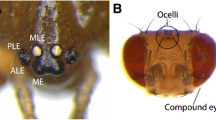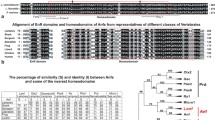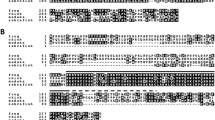Abstract
The genes otd/otx, six3, pax6 and engrailed are involved in eye patterning in many animals. Here, we describe the expression pattern of the homologs to otd/otx, six3, pax6 and engrailed in the developing Euperipatoides kanangrensis embryos. Special reference is given to the expression in the protocerebral/ocular region. E. kanangrensis otd is expressed in the posterior part of the protocerebral/ocular segment before, during and after eye invagination. E. kanangrensis otd is also expressed segmentally in the developing ventral nerve cord. The E. kanangrensis six3 is located at the extreme anterior part of the protocerebral/ocular segment and not at the location of the developing eyes. Pax6 is expressed in a broad zone at the posterior part of the protocerebral/ocular segment but only weak expression can be seen at the early onset of eye invagination. In late stages of development, the expression in the eye is upregulated. Pax6 is also expressed in the invaginating hypocerebral organs, thus supporting earlier suggestions that the hypocerebral organs in onychophorans are glands. Pax6 transcripts are also present in the developing ventral nerve cord. The segment polarity gene engrailed is expressed at the dorsal side of the developing eye including only a subset of the cells of the invaginating eye vesicle. We show that engrailed is not expressed in the neuroectoderm of the protocerebral/ocular segment as in the other segments. In addition, we discuss other aspect of otd, six3 and pax6 expression that are relevant to our understanding of evolutionary changes in morphology and function in arthropods.







Similar content being viewed by others
References
Anderson DT (1966) The comparative early embryology of the Oligochaeta, Hirudinae and Onychophora. Proc Linn Soc NSW 91(1):10–43
Arendt D, Tessmar K, de Campos-Baptista M, Dorresteijn A, Wittbrodt J (2002) Development of pigment-cup eyes in the polychaete Platynereis dumerilii and evolutionary conservation of larval eyes in Bilateria. Development 129:1143–1154
Blackburn DC, Conley KW, Plachetzki DC, Kempler K, Battelle B-A, Brown NL (2008) Isolation and expression of pax6 and atonal homologues in the American horseshoe crab, Limulus polyphemus. Dev Dyn 237(8):2209–2219. doi:10.1002/dvdy.21634
Browne W, Schmid B, Wimmer E, Martindale M (2006) Expression of otd orthologs in the amphipod crustacean, Parhyale hawaiensis. Dev Genes Evol 216:581–595
Callaerts P, Halder G, Gehring WJ (1997) Pax6 in development and evolution. Annu Rev Neurosci 20(1):483–532. doi:10.1146/annurev.neuro.20.1.483
Campbell LI, Rota-Stabelli O, Edgecombe GD, Marchioro T, Longhorn SJ, Telford MJ, Philippe H, Rebecchi L, Peterson KJ, Pisani D (2011) MicroRNAs and phylogenomics resolve the relationships of Tardigrada and suggest that velvet worms are the sister group of Arthropoda. Proc Natl Acad Sci 108(38):15920–15924. doi:10.1073/pnas.1105499108
Campos-Ortega JA, Hartenstein V (1985) The embryonic development of Drosophila melanogaster. Springer-Verlag, Berlin
Clements J, Hens K, Francis C, Schellens A, Callaerts P (2008) Conserved role for the Drosophila pax6 homolog eyeless in differentiation and function of insulin-producing neurons. Proc Natl Acad Sci 105(42):16183–16188. doi:10.1073/pnas.0708330105
Dakin WJ (1921) The eye of peripatus. Q J Microsc Sci 65:163–172
Del Bene F, Tessmar-Raible K, Wittbrodt J (2004) Direct interaction of geminin and six3 in eye development. Nature 427(6976):745–749
Doeffinger C, Hartenstein V, Stollewerk A (2010) Compartmentalization of the precheliceral neuroectoderm in the spider Cupiennius salei: development of the arcuate body, optic ganglia and mushroom body. J Comp Neurol 518(13):2612–2632. doi:10.1002/cne.22355
Dunn CW, Hejnol A, Matus DQ, Pang K, Browne WE, Smith SA, Seaver E, Rouse GW, Obst M, Edgecombe GD, Sorensen MV, Haddock SHD, Schmidt-Rhaesa A, Okusu A, Kristensen RM, Wheeler WC, Martindale MQ, Giribet G (2008) Broad phylogenomic sampling improves resolution of the animal tree of life. Nature 452(7188):745–749
Eakin RM, Westfall JA (1965) Fine structure of the eye of peripatus (Onychophora). Cell Tissue Res 68:278–300
Eriksson BJ, Tait NN (2012) Early development in the velvet worm Euperipatoides kanangrensis Reid 1996 (Onychophora: Peripatopsidae). Arthropod Structure & Development 41(5):483–493. doi:10.1016/j.asd.2012.02.009
Eriksson BJ, Tait NN, Norman JM, Budd GE (2005) An ultrastructural investigation of the hypocerebral organ of the adult Euperipatoides kanangrensis (Onychophora, Peripatopsidae). Arthropod Struct Dev 34(4):407–418. doi:10.1016/j.asd.2005.03.002
Eriksson BJ, Tait NN, Budd GE, Akam M (2009) The involvement of engrailed and wingless during segmentation in the onychophoran Euperipatoides kanangrensis (Peripatopsidae: Onychophora) (Reid 1996). Dev Genes Evol 219:249–264
Finkelstein R, Smouse D, Capaci TM, Spradling AC, Perrimon N (1990) The orthodenticle gene encodes a novel homeo domain protein involved in the development of the Drosophila nervous system and ocellar visual structures. Genes Dev 4(9):1516–1527. doi:10.1101/gad.4.9.1516
Friedrich M (2006) Ancient mechanisms of visual sense organ development based on comparison of the gene networks controlling larval eye, ocellus and compound eye specification in Drosophila. Arthropod Struct Dev 35:357–378
Gehring WJ (2004) Historical perspective on the development and evolution of eyes and photoreceptors. Int J Dev Biol 48:707–717
Griffin C, Kleinjan DA, Doe B, van Heyningen V (2002) New 3′ elements control pax6 expression in the developing pretectum, neural retina and olfactory region. Mech Dev 112(1–2):89–100. doi:10.1016/S0925-4773(01)00646-3
Hanson I, Van Heyningen V (1995) Pax6: more than meets the eye. Trends Genet 11(7):268–272. doi:10.1016/S0168-9525(00)89073-3
Hirth F, Kammermeier L, Frei E, Walldorf U, Noll M, Reichert H (2003) An urbilaterian origin of the tripartite brain: developmental genetic insights from Drosophila. Development 130:2365–2373
Huelsenbeck JP, Ronquist F (2001) MrBayes: bayesian inference of phylogeny. Bioinformatics 17:754–755
Kioussi C, O’Connell S, St-Onge L, Treier M, Gleiberman AS, Gruss P, Rosenfeld MG (1999) Pax6 is essential for establishing ventral-dorsal cell boundaries in pituitary gland development. Proc Natl Acad Sci 96(25):14378–14382. doi:10.1073/pnas.96.25.14378
Kumar JP (2009) The molecular circuitry governing retinal determination. Biochimica et Biophysica Acta (BBA) Gene Regul Mech 1789(4):306–314. doi:10.1016/j.bbagrm.2008.10.001
Li Y, Brown S, Hausdorf B, Tautz D, Denell R, Finkelstein R (1996) Two orthodenticle-related genes in the short-germ beetle Tribolium castaneum. Dev Genes Evol 206:35–45
Liu W, Lagutin O, Swindell E, Jamrich M, Oliver G (2010) Neuroretina specification in mouse embryos requires six3-mediated suppression of wnt8b in the anterior neural plate. J Clin Invest 120(10):3568–3577. doi:10.1172/jci43219
Loosli F, Koster RW, Carl M, Krone A, Wittbrodt J (1998) Six3, a medaka homologue of the Drosophila homeobox gene sine oculis is expressed in the anterior embryonic shield and the developing eye. Mech Dev 74(1–2):159–164. doi:10.1016/s0925-4773(98)00055-0
Manton SM (1949) Studies on the Onychophora VII. The early embryonic stages of Peripatopsis and some general considerations concerning the morphology and phylogeny of the Arthropoda. Philos Trans R Soc Lond 233(606):483–580
Martinez-Morales JR, Signore M, Acampora D, Simeone A, Bovolenta P (2001) Otx genes are required for tissue specification in the developing eye. Development 128(11):2019–2030
Mayer G (2006) Structure and development of onychophoran eyes: what is the ancestral visual organ in arthropods? Arthropod Struct Dev 35(4):231–245. doi:10.1016/j.asd.2006.06.003
Nielsen C (2001) Animal evolution, interrelationships of the living phyla, 2nd edn. Oxford University, Oxford
Ostrin EJ, Li Y, Hoffman K, Liu J, Wang K, Zhang L, Mardon G, Chen R (2006) Genome-wide identification of direct targets of the Drosophila retinal determination protein eyeless. Genome Res 16(4):466–476. doi:10.1101/gr.4673006
Paulus HF (1979) Eye structure and the monophyly of the Arthropoda. In: Gupta AP (ed) Arthropod phylogeny. Van Nostrand Reinhold, New York, pp 299–383
Ronquist F, Huelsenbeck JP (2003) MRBAYES 3: Bayesian phylogenetic inference under mixed models. Bioinformatics 19:1572–1574
Royet J, Finkelstein R (1995) Pattern formation in Drosophila head development: the role of the orthodenticle homeobox gene. Development 121(11):3561–3572
Sedgwick A (1887) The development of the Cape species of Peripatus. Part III. On the changes from stage A to stage F. Q J Micr Sci 27:467–550
Seimiya M, Gehring WJ (2000) The Drosophila homeobox gene optix is capable of inducing ectopic eyes by an eyeless-independent mechanism. Development 127(9):1879–1886
Seo H-C, Curtiss J, Mlodzik M, Fjose A (1999) Six class homeobox genes in Drosophila belong to three distinct families and are involved in head development. Mech Dev 83(1–2):127–139. doi:10.1016/S0925-4773(99)00045-3
Steinmetz P, Urbach R, Posnien N, Eriksson J, Kostyuchenko R, Brena C, Guy K, Akam M, Bucher G, Arendt D (2010) Six3 demarcates the anterior-most developing brain region in bilaterian animals. EvoDevo 1(1):14
Steinmetz PRH, Kostyuchenko RP, Fischer A, Arendt D (2011) The segmental pattern of otx, gbx and hox genes in the annelid Platynereis dumerilii. Evol Dev 13(1):72–79. doi:10.1111/j.1525-142X.2010.00457.x
Storch V, Ruhberg H (1993) Onychophora. Microscopic Anatomy of Invertebrates, Onychophora, Chilopoda and lesser Protostomata. Wiley-Liss, New York
Telford M, Thomas R (1998) Expression of homeobox genes shows chelicerate arthropods retain their deutocerebral segment. Proc Natl Acad Sci USA 95:10671–10675
Walker M, Tait N (2004) Studies of embryonic development and the reproductive cycle in ovoviviparous Australian Onychophora (Peripatopsidae). J Zool 264:333–354
Wurst W, Auerbach AB, Joyner AL (1994) Multiple developmental defects in engrailed-1 mutant mice: an early mid-hindbrain deletion and patterning defects in forelimbs and sternum. Development 120(7):2065–2075
Acknowledgment
This work was funded by the Austrian Science Fund (FWF): M1296-B17 to BJE under the Lise Meitner Programme. We are grateful to the labs of Ulrich Technau and Thomas Hummel, University of Vienna, for providing workspace and lab equipment. We thank Noel Tait for helping with the collection of onychophorans and writing application of collecting permits. We gratefully acknowledge the support of the NSW Government Department of Environment and Climate Change by provision of permits to collect and export onychophorans.
Author information
Authors and Affiliations
Corresponding author
Additional information
Communicated by: S. Roth
Electronic supplementary material
Rights and permissions
About this article
Cite this article
Eriksson, B.J., Samadi, L. & Schmid, A. The expression pattern of the genes engrailed, pax6, otd and six3 with special respect to head and eye development in Euperipatoides kanangrensis Reid 1996 (Onychophora: Peripatopsidae). Dev Genes Evol 223, 237–246 (2013). https://doi.org/10.1007/s00427-013-0442-z
Received:
Accepted:
Published:
Issue Date:
DOI: https://doi.org/10.1007/s00427-013-0442-z




